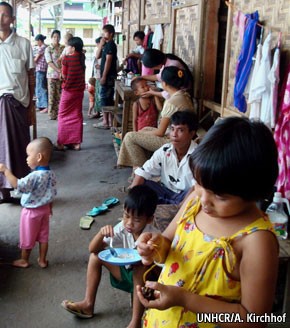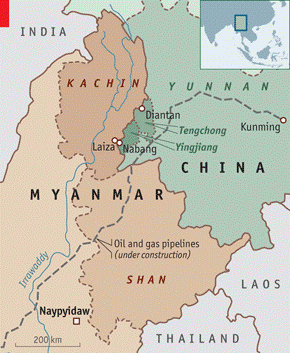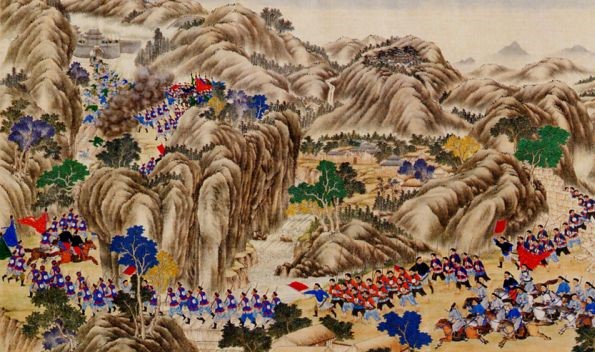

 字體:小 中 大
字體:小 中 大 |
|
|
|
| 2019/10/27 21:21:20瀏覽153|回應0|推薦0 | |
以下是有關中國-緬甸關係,在經濟學者雜誌的1-2月的內文文章,主要是有關克欽族(在緬甸的華人移民)、中國在東南亞的影響力問題,和元朝中國之後與緬甸的歷史。這篇不多作評論,有興趣的讀者可以至筆者在經濟學者網頁上討論回文全本 https://www.economist.com/user/2791934/comments 翻到2015年11月17日,2016年4月8日筆者分別曾發過對於「A New Era」,即翁山蘇姬為主的NLD政黨在緬甸以普選獲得完全執政,「The Burma Road」提及中緬貿易在臘戌地方繁榮盛況的討論區回文:
Myanmar and ChinaThe Kachin dilemmaOver the border, the Kachin conflict causes headaches for ChinaFeb 2nd 2013 | DIANTAN AND YINGJIANG |From the print edition
No going home
ZHANG SHENGQI is nervous of the police. In Yingjiang, a Chinese county bordering on Myanmar (see map), he asks the driver of his car to stop so he can check whether he is being followed. Mr Zhang, a Chinese Christian, smuggles food and clothing over the border into Myanmar to help Kachin refugees, many of whom share his beliefs. The Chinese authorities, torn between their support for the Myanmar government and strong local ties with the Kachin, keep a wary watch.
In this section · The Kachin dilemma The fighting in Kachin state has created a series of problems for China. It worries that it might trigger a large-scale influx of refugees across the porous border into Yunnan province, where Yingjiang is located. The Kachin Independence Army (KIA), whose administrative centre in the town of Laiza lies just over the border, may be about to fall to the Burmese government army, but few expect peace. Mr Zhang and fellow activists from China are likely to remain busy in the dozens of camps inside Myanmar that house tens of thousands of refugees close to China’s border.
China wants to maintain good relations with Myanmar, not least to counter Myanmar’s recent warming of relations with America. China has big interests in energy and resources in Myanmar. Its investments there include at least $2 billion spent on oil and gas pipelines crossing Myanmar into Yunnan that are due to be completed in May. China sees this project as one of huge importance to its energy security, helping it avoid dependence on shipments coming through the Strait of Malacca. But it also wants to keep on good terms with the Kachin, who share ethnicity with minorities on the Chinese side of the border.
Most of the jade and wood that form the backbone of trade in the towns of Yingjiang county come from Kachin state. In recent years China’s burgeoning economic ties with Kachin have benefited some of the state’s inhabitants, but are also seen by some as exploitative. China does not want to fuel such resentment by siding too closely with the Burmese army in its fight against the KIA.
Mr Zhang operates in the grey zone created by these conflicting pressures. The authorities elsewhere in China are often quick to stop organised activities by people like him: “house-church” Christians who shun state-backed religious groups (Mr Zhang spent four months in jail in 2003 on charges of leaking state secrets after writing a report on the persecution of house churches). After the fighting broke out in Kachin in 2011 he moved from Beijing to Yunnan to set up an NGO to help victims of the conflict. To mobilise support he opened an account on China’s Twitter-like microblog service, Sina Weibo, under the name woai nanmin, meaning “I love refugees”. He says he raised about 100,000 yuan ($16,000) in cash donations within China last year. This month alone Chinese supporters have provided another 50,000 yuan.
Given the reluctance of China to become directly involved in the humanitarian crisis, and the Burmese government’s refusal of international aid in Kachin and Shan states, the semi-covert work of NGOs such as Mr Zhang’s play a vital role. To evade Chinese border guards he sneaks over at night, away from official crossing points (the border in Yingjiang is marked by a river). Since late last year most non-residents have been barred even from entering Nabang, the Chinese border town opposite Laiza. Nabang has been hit by stray projectiles fired by the Burmese army.
Officials have tried to keep the refugee crisis from spilling into China. On the edge of the border town of Diantan in Yingjiang’s neighbouring county of Tengchong, a Burmese activist points to dilapidated wooden houses where refugees are renting cheap accommodation. There are about 1,000 Burmese in these squalid shacks, he estimates, part of the 4,000 or so refugees who crossed into Diantan last April. The government briefly kept them in a vehicle-repair yard and provided them with food and medical help (the Chinese characters for Jesus, scrawled on one wall, are a reminder of their stay). But two or three weeks later most of them were escorted back to Myanmar to be housed in refugee camps near the border (see picture). Some camps are run by the government, some by the Kachin.
Like Myanmar, China bars access to Kachin refugees by international groups, including the UNHCR. According to Human Rights Watch, a New York-based NGO, there were between 7,000 and 10,000 Burmese refugees in Yunnan in June last year. The Chinese authorities deny reports that they have sent Kachin refugees back against their will.
Mr Zhang, the Chinese Christian, says the authorities probably know about his activities but turn a blind eye. He points out, however, that officials could be doing a lot more to help. The government has built four refugee camps around Nabang, but they remain empty. A fellow Christian activist, Hua Huiqi, says he has been visiting Myanmar to advise the Kachins on media relations. “I have been a rights activist in China and now I’ve gone international,” he says proudly. China’s tolerance for such activities is being tested.
South-East Asia and ChinaAll change at ASEANHopes for calmer times under this year’s new managementFeb 9th 2013 | BANDAR SERI BAGAWAN |From the print edition (缺圖)
EVEN the most ardent supporters of the Association of South-East Asian Nations (ASEAN) concede that last year was a pretty disastrous one for the ten-country grouping. Replacing the region’s usual mild-mannered consensus was an unprecedented eruption of rowing and bickering, all on verypublic and humiliating display at its summit meetings. The root of it all was the dispute over China’s territorial claims in the South China Sea. Cambodia, closest to China in the grouping and the ASEAN chairman in 2012, tried to press its ally’s claims. This provoked a heated reaction from some of ASEAN’s own members, notably Vietnam and the Philippines, with claims of their own. For several weeks last year the Philippine navy was involved in a tense stand-off with Chinese ships near the disputed Scarborough shoal. In this section · All change at ASEAN · Rogue Related topics · Asia · China · Politics · Association of South-East Asian Nations All the politicking over the South China Sea has diverted political energy from ASEAN’s most pressing internal task, which is to form a new EU-like economic community by 2015. At the same time, the United States last year deepened its strategic ties with Vietnam, the Philippines, Singapore and Indonesia as part of an “Asia pivot”. All this has stoked fears that, in an era of rising great-power rivalry, ASEAN might not be able to stick together. Getting ASEAN back on track will be hard, and much of the burden for doing so now falls on tiny Brunei. The oil-rich sultanate, a dot on the coast of Borneo, is home to just 400,000 out of ASEAN’s population of 600m. Brunei has taken over ASEAN’s annual rotating chairmanship from Cambodia and will host this year’s summits. At the same time, the organisation has acquired a new secretary-general. Le Luong Minh, a Vietnamese former diplomat, has succeeded Thailand’s Surin Pitsuwan. That the baton should pass to ASEAN’s smallest member at this moment of almost existential crisis has caused concern for some. Brunei has only 30-odd people working on the ASEAN brief in its foreign ministry. And next year it will be followed as chairman by the wholly untested and still controversial Myanmar. Yet Lim Jock Seng, Brunei’s deputy minister for foreign affairs, argues that these anxieties are misplaced. For a start, apparent shortcomings can be turned to ASEAN’s advantage. Brunei may be small, he says, but that also makes the country relatively unthreatening, especially to China. Had the chair passed to Vietnam or the Philippines at this point, all hell might have broken loose. Although Brunei is also a country with an interest in the South China Sea that China contests, its claim is the smallest—just one submerged reef. Last, being extremely rich puts Brunei in the happy position of being free of a financial reason to kowtow to China—or anyone for that matter. That was Cambodia’s undoing last year, and could yet be Myanmar’s next. Mr Lim believes that Brunei’s relative obscurity should help it practise the “quiet diplomacy” that everyone agrees is needed to repair the breach with China. He has already been to Beijing to talk to Chinese officials and says that both sides agree that the ASEAN-China relationship is “bigger than the South China Sea issue”. Opportunities for joint economic development ought really to trump it. The main sticking-point is that although ASEAN is keen to implement a “code of conduct” covering the South China Sea disputes, China refuses to acknowledge a collective position. Instead, it prefers bilateral negotiations with each claimant country. Mr Lim, however, hopes to start talks with China on the code of conduct and to have something “concrete that we can sign” by the main ASEAN summit in October. If so, that would be a coup, especially if China’s new leader, Xi Jinping, does not signal a softer line in the meantime. Vietnam’s Mr Minh will have much to do as secretary-general. His country is overtly suspicious of Chinese intentions, and he might face pressure to tilt the group further against China. Until now, however, he has been impeccably diplomatic. He will probably focus on completing the ASEAN economic community, which is exactly what most of ASEAN wants him to do—so long as Brunei can successfully steer the grouping away from the diplomatic reefs of the South China Sea. · 10 ·
Chinas history in MyanmarUnruly linesFeb 11th 2013, 9:17 by J.J. | BEIJING
THE border between Yunnan province and northern Myanmar (formerly Burma) has always been porous. To the people who live in the region, the border is a crooked mark on other people’s maps, an arbitrary boundary snaking its way 2,400 kilometres through rugged and wild terrain. The authorities in Beijing have seen the same land as a lawless borderland, a place to be controlled.
In October 2012 the trial of a Burmese drug lord, Naw Kham, who was sentenced to death for the killing of 13 Chinese sailors on the Mekong river in northern Thailand, sharpened the sense in China that the Sino-Burmese border remains a breeding ground for criminal gangs and drug traffickers. The Chinese are also growing steadily more alarmed about the conflict between Myanmar’s army and the Kachin Independence Army (known by the perhaps inauspicious initials “KIA”) and the potential of its spilling over into China. Last month, the generals in Myanmar ordered a major offensive, deploying fighter jets and heavy artillery against KIA positions. Chinese authorities fear a humanitarian crisis on their territory, should the thousands of Karen and Kachin displaced from Kachin state and living in refugee camps in northern Yunnan be forced to seek safe haven farther from Myanmar, in southern Yunnan.
The people of this ecologically and ethnically diverse region have taken refuge on ether side of the border for centuries, according to various regional balances of power. For nearly as long they have frustrated attempts by both Burmese and Chinese governments to impose order. In “The Art of Not Being Governed”, James C. Scott argues that “Zomia”, a name he gives to the swath of highland communities that stretches from the edge of Tibet to Vietnam’s central highlands, is the largest remaining region of the world not to have been fully incorporated into nation-states.
The Mongol invasions of the mid-13th century ended nearly 500 years’ rule of an independent kingdom in what is today Yunnan. Dynasties subsequent to the Mongols’ Yuan have all continued to claim Yunnan as a province—but administering it is another matter. Officials were often posted to the province as a form of punishment. They saw it as being a dangerous, disease-ridden backwater inhabited mostly by non-Chinese who stubbornly refused the officials’ benevolent efforts to “civilise” them.
The Manchu conquest of China in the mid-17th century and the founding of the Qing dynasty marked the beginning of an especially turbulent era in Sino-Burmese relations. Throughout the Qing period, Yunnan, and especially the Sino-Burmese frontier, became a haven for anyone eager to avoid unnecessary involvement with the state. It was a Wild West on the Mekong. Illegal miners, smugglers, fugitives and would-be warlords lived side-by-side with local ethnic groups, corrupt Qing officials, and Burmese pirates. Conflicts were frequent and bloody.
The last claimant to the throne of the defeated Ming dynasty spent most of his reign on the run, with his court in tow. He finally fled into Burma seeking refuge. The Manchu army stormed across the border and demanded the Burmese king hand over his guest, to be executed, or else prepare to fight.
The Qing empire also fought a series of border wars against the Burmese in the middle of the 18th century. They launched four invasions into Burma in the span of just a few years, each venture proving more disastrous than the one before. The Qing commanders initially tried to hide the extent of their defeats. After each display of official incompetence the emperor grew more enraged until finally he unleashed the full fury of the elite Manchu bannermen against the Burmese king. So confident was the emperor in Manchu military prowess that even as his troops were mustering, he was already considering plans for how to incorporate a conquered and chastened Burma into the empire. Unfortunately for him, the Manchu troops were more adept at fighting their wars of conquest in the arid climate of Central Asia. Tropical heat and disease—especially dysentery—decimated their ranks in Burma. Hoping to spare his empire further humiliation, the emperor called it a draw. Two decades later, after trade and diplomatic relations had been restored between Burma and the empire, the emperor decided that, notwithstanding the evidence, the Qing had won the war after all.
Subsequent Chinese governments would gain a modicum of control over Yunnan. But even into the 20th century local leaders maintained a high level of autonomy, and the frontier continued to harbour its share of fugitives and rebels. In the aftermath of the Communist victory in 1949, thousands of troops nominally loyal to Chiang Kai-shek fled into Burma and Thailand. Many continued the fight, supported with arms and money from Taiwan and the United States. Others joined criminal gangs, supporting themselves through poppies and piracy.
Today, as the governments of Burma and China expand their reach into the isolated valleys and hillsides of the Sino-Burmese frontier, local communities are finding it increasingly difficult to maintain their autonomy. The Chinese government sees this as a triumph for nation-building and the rule of law. The local people however have a longer memory. Over the past millennium they have been conquered many times, but never allowed themselves to be truly governed. Why start now? (Picture credit: Wikimedia Commons)
|
|
| ( 心情隨筆|心情日記 ) |













